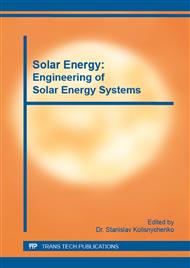p.198
p.204
p.210
p.216
p.221
p.227
p.233
p.239
p.245
Control System for a Mobile Platform in a Test System of Solar Collector Based on State Machine
Abstract:
A mobile test system for solar collector is introduced in this paper. The mobile test system for solar collector is a flexible and convenient testing device. Its design is much more difficult than that of a fixed test system for solar collector, because it needs consideration so as to make the test system accurate, reduce the volume of the test system, ensure the stability of the test system, increase corresponding removed devices and so on. For an effective integration of the test system and a vehicle, this paper discusses a mobile platform and its control system. A movement control of the subsystem adopts ac servo system based on PC. The system takes LabVIEW which is used in a virtual instrument as the development platform. And it employs a state machine model to monitor the process of removing and taking back for the mobile platform.
Info:
Periodical:
Pages:
221-226
Citation:
Online since:
November 2012
Authors:
Keywords:
Price:
Сopyright:
© 2012 Trans Tech Publications Ltd. All Rights Reserved
Share:
Citation:



